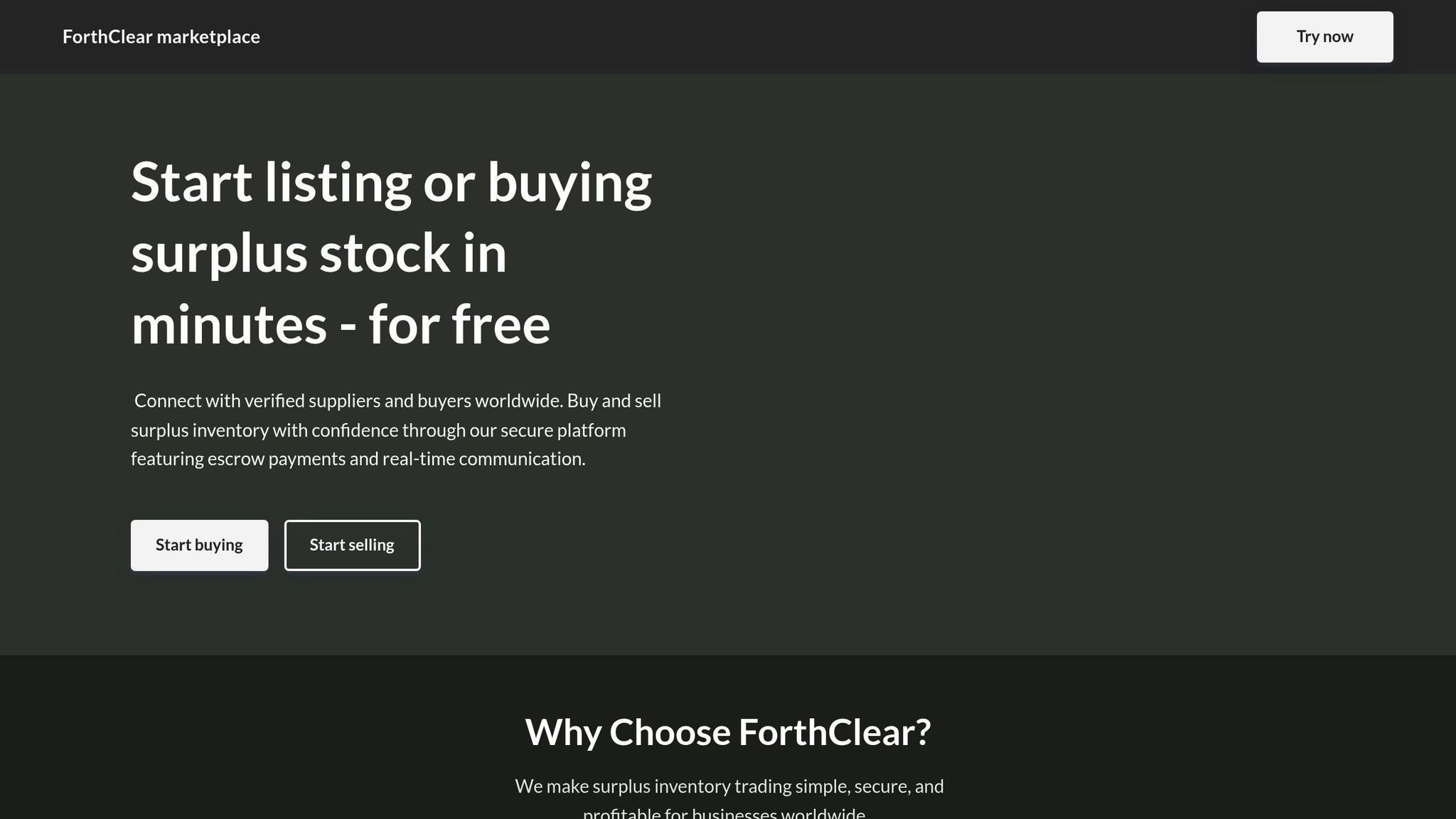Liquidation and surplus sales are two strategies businesses use to handle excess inventory. Both aim to free up space and recover costs, but they differ in purpose, speed, and outcomes. Here's the breakdown:
- Liquidation: Ideal for quick cash flow during financial stress or business closure. Items are sold at steep discounts (5–30% of original price), often including damaged or outdated goods. It’s fast but may hurt profits and brand perception.
- Surplus Sales: Best for planned stock management. High-quality, unused items are sold at moderate discounts to maintain value. This method takes more time but yields better returns and preserves brand reputation.
Key Takeaways:
- Liquidation focuses on speed, sacrificing profit for immediate cash.
- Surplus sales prioritize value recovery and careful planning.
- Both methods reduce storage costs and address overstock issues.
Quick Comparison:
| Factor | Liquidation | Surplus Sales |
|---|---|---|
| Goal | Fast cash | Manage excess stock |
| Item Condition | Mixed (new, old, damaged) | New, unused |
| Discounts | Deep cuts (5–30%) | Moderate cuts |
| Target Buyers | Bargain seekers, resellers | Quality-focused buyers |
| Time Frame | Days to weeks | Weeks to months |
| Risk | High (low returns, brand impact) | Low (better returns, brand-safe) |
Bottom Line: Choose liquidation for urgent needs and surplus sales for strategic inventory management. The right approach depends on your business goals, stock quality, and urgency.
How Liquidating Unwanted Goods Became A $644 Billion Business
Main Differences in Liquidation and Surplus Sales
Liquidation and surplus sales are two ways to deal with too much stock. Liquidation helps a business get cash fast. Surplus sales are better for when a business plans to sort out its extra stock.
What Starts Them and What They Aim For
Liquidation often starts when a business is in money trouble or shutting down. The big aim is to change items into cash fast, usually by cutting prices a lot to get buyers fast.
Surplus sales, on the other way, are a way a business plans ahead to handle extra stock. It helps clear out stock that isn't needed, make more room in storage places, and get back some money from these items. With more time to find buyers, surplus sales may bring in more money than liquidation.
What The Stock Is Like and What Buyers Expect
In liquidation, items can be new, used, or broken. This draws people who want a bargain, those who sell things again, and shops that sell things for less. They care more about a low price than how good the items are.
Surplus sales are mostly new items in top shape. These sales pull in buyers who want good items but don't mind if the price is a bit less than usual. Unlike liquidation, surplus sales focus on keeping items good and may even pick items that people want more because of their look or brand power.
Table to Show: Liquidation vs Surplus Sales
| Factor | Liquidation | Surplus Sales |
|---|---|---|
| Main Goal | Get cash fast in tight spots | Make room and fix stock levels |
| Item Shape | Mixed (new, old, or broken) | New, not used, top shape |
| Price Plan | Big cuts, quick sale | Small cuts, want good money back |
| Who Buys | Deal seekers, re-sellers, cheap stores | Careful buyers, firms wanting deals |
| When Sold | Right now (days to weeks) | Set time frame |
| Why Sell | Money woes, shutting down, need cash quick | Too much stock, season end |
| Risk | High chance of small returns | Less risk, steady results |
| How Much to Sell | All items | Just some items or extra stock |
Selling off works well when you need cash fast. But selling extra items fits if a firm wants to fix its stock count. These facts make it clear which way to pick, prepping you for the next part about when to use each plan.
When to Pick Selling All vs. Selling Extra
Choosing how to move extra stock relies on your firm's money state, how good your goods are, and how fast you need to act to stop losing or guard your name.
When Selling All Is the Best Pick
Selling all is good when your business is out of funds, closing, or has stock that isn't worth much now. This way gets you quick cash - switching stock to money in days or weeks - even if it means taking just 5–30% of the first price.
If your firm is ending, keeping stock for a better deal is no good. Selling all makes sure you move goods fast, even if they're broke, too old, or not liked by your regulars anymore. Buyers of this type find worth in things many would not look at. Also, if holding costs are too high, selling all frees up space and saves money each month. For example, in the 2023 sales year, U.S. shops had $740 billion in too much goods from having too much - a big sign of how key it is to clear stock fast.
Next, let's see when selling extra might be the best plan.
When Selling Extra Works Best
Selling extra fits firms that can plan and want to keep their earnings high. This works well for clearing goods tied to a time of year, getting ready for new goods, or setting the right amount of stock. If you have winter coats in spring or Halloween stuff in November, selling extra lets you sell those when folks want them again, not rushing to get rid of them.
When you bring in new goods, selling extra helps you move old stock without big price cuts that could hurt your name. Firms with steady money can wait for good deals, making the most of their stock worth. This way also keeps your name safe by not letting folks think your goods are bad. If you have enough space and the costs are okay, holding onto extra stock until things get better can be a wise move.
Risks and Gains of Each Way
Each way has its own good points and hard parts, which can touch both your cash and your name.
Selling all gives quick money flow and fast relief from too much stock. It’s a swift way to make cash for bills or other uses, and cuts holding costs too. As Alix Fraser, Product Content Expert at Lightspeed, says:
"Inventory liquidation is not just about clearing shelves - it's a strategic tool for improving cash flow, optimizing storage and preparing your business for future success."
Yet, selling off assets has its bad sides. Taking only 5–30% of the first price can cut deep into your profits, and big price cuts might make people think less of your brand.
Surplus sales, in a different way, can keep your profit high and protect the worth of your brand. You can often choose your own prices and pick who buys more with care. Still, this way needs a lot more time and carefulness - finding the right buyers could take months, and costs of keeping things stored might reduce your profits. Changes in the market can also change the worth of what you have while you wait.
How to Maximize Returns from Excess Inventory
Careful planning is essential when dealing with surplus stock. Whether you're gearing up for liquidation or surplus sales, taking the right steps can help you get the most out of your excess inventory.
Preparing Inventory for Sale
Start by creating a detailed inventory catalog. Include descriptions, quantities, conditions, and original retail values of your items. This documentation not only keeps you organized but also strengthens your position when negotiating with potential buyers.
Next, evaluate the condition of your stock. Items in good shape are more appealing, but if there are defects, make sure to clearly communicate them. Transparency helps set realistic expectations and builds trust with buyers, reducing the chance of disputes later on.
You can also make your inventory more attractive with small but impactful updates. Refresh displays, improve packaging, or strategically position items to grab buyers' attention. Even minor tweaks like these can significantly enhance appeal.
Take a page from KOOKAI's playbook. This fashion retailer centralized its inventory across its U.S. and U.K. online stores, allowing them to shift stock to regions with higher demand. This approach helped them minimize waste while maximizing sales opportunities.
Once your inventory is ready, it’s time to explore sales strategies that fit your goals.
Surplus Sales Methods That Work
Dynamic pricing and bundling are effective ways to move slow-selling stock while encouraging bulk purchases. For instance, targeting startup buyers or leveraging local online marketplaces can cut down on shipping costs and speed up sales.
Another option is to use auction formats. Competitive bidding can work particularly well for unique or specialized items. Additionally, offering flexible payment options like "Buy Now, Pay Later" can make purchases more accessible, attracting more buyers.
If you’re working with tight deadlines, these strategies can also be adapted for quick liquidation.
Tips for Better Liquidation Results
When speed is critical, focus on analyzing your inventory by factors like demand, shelf life, and costs. Use this data to set firm minimum prices that align with your goals.
Timing is another key factor. Align your sales with favorable market conditions and ensure clear communication across all channels to maximize visibility. Data analytics can also guide your decisions. For example, Aquatic AV used an inventory dashboard to gain better visibility, improving their customer fill rate from 79% to 99% within a year. This approach helped them manage excess inventory while prioritizing stock-outs.
Don’t forget to address legal and financial considerations. Understanding local laws and potential financial impacts can save you from costly mistakes. Consulting with legal or financial advisors can provide valuable guidance when needed.
Lastly, think about donating unsold items. Donations not only offer potential tax benefits but also improve your brand's public image. This can be especially helpful for items that are unlikely to sell through conventional methods.
sbb-itb-bc600a0
Tools and Platforms for Inventory Management
Effectively managing excess inventory starts with the right technology. With retailers in the US and Canada losing over $349 billion annually due to stock issues like overstocks and out-of-stocks, having the proper tools in place can make a huge difference. Interestingly, 37% of global retail businesses have already embraced automated inventory management, signaling a growing shift toward digital solutions.
When selecting a platform for handling surplus inventory, it’s important to prioritize features that meet your business's specific needs. For instance, real-time inventory tracking ensures automated, up-to-the-minute stock updates, while detailed reporting and analytics provide dashboards that guide smarter decisions about inventory flow. One platform that excels in these areas is ForthClear, offering specialized features designed to simplify surplus inventory management.
ForthClear's Key Features

ForthClear is built to tackle the challenges of managing surplus stock with tools tailored for efficiency and ease of use. Its secure escrow payment system safeguards transactions by holding funds until both buyers and sellers are satisfied, fostering trust through verified suppliers who meet stringent quality standards.
To help businesses clear out surplus inventory quickly, the platform offers bulk pricing options and supports CSV inventory uploads, enabling sellers to list large quantities of items in one go. With sales analytics, businesses can identify which items sell fastest and at what price, helping refine their sales strategies for surplus goods.
Another standout feature is direct messaging, which allows buyers and sellers to communicate instantly about product details, quantities, and pricing. This is especially useful for surplus items that might have unique needs or require specific handling instructions.
How ForthClear Supports Buyers and Sellers
ForthClear goes beyond basic functionality to create a seamless experience for both buyers and sellers. Its order tracking system offers clear visibility into shipment status, reducing uncertainty and building confidence in the transaction process.
The platform’s category-based browsing helps buyers find exactly what they’re looking for - whether it’s electronics, clothing, or home goods - without wasting time. This organized structure increases the chances of successful matches between sellers and buyers.
For surplus inventory, where prices can fluctuate significantly from original retail values, ForthClear’s quote negotiation feature is invaluable. Buyers can submit requests for quotes (RFQs), and sellers can respond with tailored offers based on factors like quantity, condition, or urgency.
Additionally, ForthClear’s seamless integration capabilities allow businesses to connect the platform with existing systems like accounting software, CRM tools, or ERP platforms. This eliminates the need for manual data entry and ensures accurate records across all operations.
Reducing Waste Through ForthClear
ForthClear doesn’t just help businesses financially - it also promotes sustainable practices. By enabling the sale of surplus inventory that might otherwise end up in landfills, the platform supports the circular economy and helps reduce waste.
The platform’s stock aging management tools alert businesses to items nearing expiration or becoming outdated. This early warning system gives companies a chance to move these products through surplus channels before they lose value.
For businesses with multiple locations, location-wise stock management provides centralized oversight of surplus inventory across warehouses or stores. This feature allows businesses to transfer slow-moving items to locations with higher demand, maximizing their recovery value and minimizing losses.
Conclusion
This guide has explored both liquidation and surplus sales, highlighting how these strategies can help businesses clear out excess inventory effectively. Here's a quick recap of how to make the most of these approaches.
When managing surplus stock, the first step is selecting the right strategy. Liquidation is ideal for businesses needing quick cash flow, as it moves inventory swiftly, albeit at a lower return due to steep discounts. On the other hand, surplus sales work better for high-quality, new inventory, offering higher recovery rates if time allows for a more deliberate approach.
Success in either method depends on solid preparation. Accurate inventory records and working with reliable platforms can significantly improve recovery rates. For businesses regularly dealing with excess stock, tracking metrics like recovery rates, time to sale, and inventory turnover can provide valuable insights to enhance future strategies.
Companies like ForthClear simplify this process by offering secure transactions, verified buyers and sellers, and tools that make inventory clearance more efficient. These solutions not only help maximize returns but also reduce waste by extending the lifecycle of products.
A well-thought-out strategy for handling excess inventory is vital for maintaining profitability and operational efficiency. With proper planning, the right tools, and a clear approach, businesses can turn potential losses into opportunities for recovery and growth.
FAQs
How can a business choose between liquidation and surplus sales to manage excess inventory?
Choosing between liquidation and surplus sales comes down to your business objectives, how quickly you need to clear inventory, and the value you hope to recover.
If your priority is to free up storage space fast or generate cash quickly - especially for outdated or slow-moving products - liquidation is the way to go. This method typically involves selling large quantities of inventory at heavily discounted prices through specialized buyers or marketplaces.
Alternatively, surplus sales are a better fit if you’re looking to maximize profit over time. This approach focuses on selling extra inventory at reduced prices through strategies like promotions, direct-to-consumer sales, or exclusive offers for loyal customers.
When deciding, think about factors such as urgency, profit potential, and how well your products match current market demand.
What are the risks and benefits of using surplus sales to manage extra inventory?
Surplus Sales: A Smart Inventory Management Strategy
Surplus sales are a practical way to handle excess inventory, offering several advantages. First, they can free up much-needed storage space, making room for new products. Second, they allow businesses to recover costs by turning unsold stock into revenue. And finally, they help maintain balanced inventory levels, reducing the chance of overstock and its associated headaches. Plus, selling surplus can cut down on waste and streamline supply chain operations.
That said, there are some risks that come with surplus stock. Holding onto extra inventory for too long can lead to higher storage costs, strain on cash flow, and the danger of items becoming outdated or unsellable. For businesses dealing with perishable goods or time-sensitive products, the stakes are even higher - spoiled goods can translate directly into lost revenue. To avoid these pitfalls, it’s crucial to have a well-thought-out plan for identifying, managing, and selling surplus inventory quickly and efficiently.
What steps can businesses take to prepare inventory for liquidation while protecting profits and their brand reputation?
To handle inventory liquidation effectively, businesses should begin by assessing the value of their stock. This step helps set competitive pricing that strikes the right balance between profitability and quick turnover. Pricing your products accurately ensures you get the most out of your inventory without selling yourself short.
After that, it’s crucial to select reliable sales channels that align with your brand’s image. Opting for reputable marketplaces or trusted partners not only safeguards your brand’s reputation but also helps prevent your products from being perceived as undervalued. Be cautious with heavy discounting, as it can negatively impact how customers view your brand in the long run.
Lastly, a well-thought-out liquidation strategy is key. This means organizing your inventory to make sales as seamless as possible, streamlining logistics, and analyzing past efforts to refine your approach. By following these steps, businesses can effectively clear out surplus stock while protecting both their profits and their brand’s standing.


